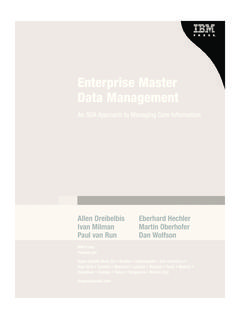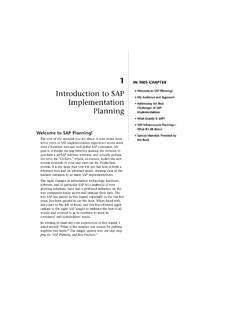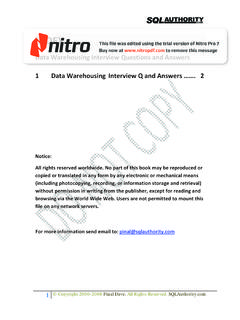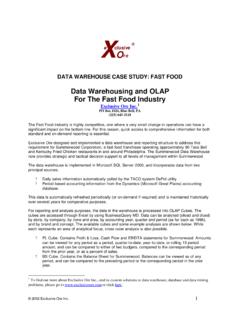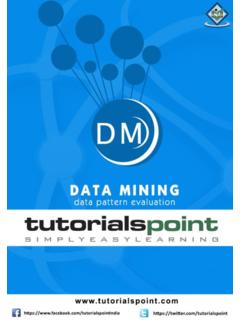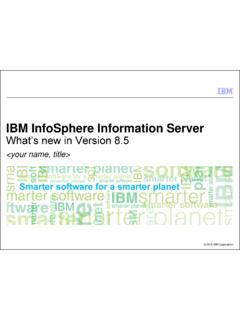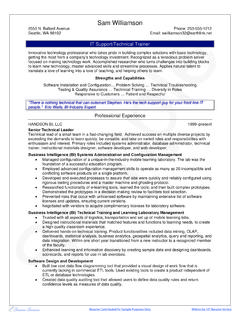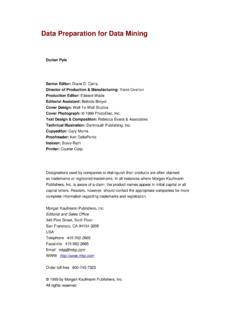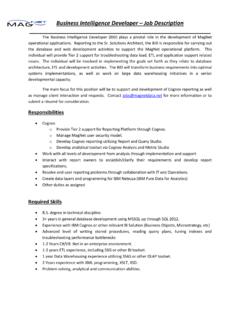Transcription of CHAPTER Introduction to Data Warehousing
1 CompRef8 / data Warehouse Design: Modern Principles and Methodologies / Golfarelli & Rizzi / 039-11 Introduction to data WarehousingInformation assets are immensely valuable to any enterprise, and because of this, these assets must be properly stored and readily accessible when they are needed. However, the availability of too much data makes the extraction of the most important information difficult, if not impossible. View results from any Google search, and you ll see that the data = information equation is not always correct that is, too much data is simply too Warehousing is a phenomenon that grew from the huge amount of electronic data stored in recent years and from the urgent need to use that data to accomplish goals that go beyond the routine tasks linked to daily processing.
2 In a typical scenario, a large corporation has many branches, and senior managers need to quantify and evaluate how each branch contributes to the global business performance. The corporate database stores detailed data on the tasks performed by branches. To meet the managers needs, tailor-made queries can be issued to retrieve the required data . In order for this process to work, database administrators must first formulate the desired query (typically an aggregate SQL query) after closely studying database catalogs. Then the query is processed. This can take a few hours because of the huge amount of data , the query complexity, and the concurrent effects of other regular workload queries on data . Finally, a report is generated and passed to senior managers in the form of a years ago, database designers realized that such an approach is hardly feasible, because it is very demanding in terms of time and resources, and it does not always achieve the desired results.
3 Moreover, a mix of analytical queries with transactional routine queries inevitably slows down the system, and this does not meet the needs of users of either type of query. Today s advanced data Warehousing processes separate online analytical processing (OLAP) from online transactional processing (OLTP) by creating a new information repository that integrates basic data from various sources, properly arranges data formats, and then makes data available for analysis and evaluation aimed at planning and decision-making processes (Lechtenb rger, 2001).1 CHAP 14/21/09 3:23:27 PMCompRef8 / data Warehouse Design: Modern Principles and Methodologies / Golfarelli & Rizzi / 039-1 2 D a t a W a r e h o u s e D e s i g n : M o d e r n P r i n c i p l e s a n d M e t h o d o l o g i e s 2 D a t a W a r e h o u s e D e s i g n : M o d e r n P r i n c i p l e s a n d M e t h o d o l o g i e sLet s review some fields of application for which data warehouse technologies are successfully used.
4 Trade Sales and claims analyses, shipment and inventory control, customer care and public relations Craftsmanship Production cost control, supplier and order support Financial services Risk analysis and credit cards, fraud detection Transport industry Vehicle management Telecommunication services Call flow analysis and customer profile analysis Health care service Patient admission and discharge analysis and bookkeeping in accounts departmentsThe field of application of data warehouse systems is not only restricted to enterprises, but it also ranges from epidemiology to demography, from natural science to education. A property that is common to all fields is the need for storage and query tools to retrieve information summaries easily and quickly from the huge amount of data stored in databases or made available by the Internet.
5 This kind of information allows us to study business phenomena, learn about meaningful correlations, and gain useful knowledge to support decision-making Decision Support SystemsUntil the mid-1980s, enterprise databases stored only operational data data created by business operations involved in daily management processes, such as purchase management, sales management, and invoicing. However, every enterprise must have quick, comprehensive access to the information required by decision-making processes. This strategic information is extracted mainly from the huge amount of operational data stored in enterprise databases by means of a progressive selection and aggregation process shown in Figure 1-1 Information value as a function of 24/21/09 3:23:28 PM C h a p t e r 1 : I n t r o d u c t i o n t o D a t a W a r e h o u s i n g 3 CompRef8 / data Warehouse Design: Modern Principles and Methodologies / Golfarelli & Rizzi / 039-1 C h a p t e r 1 : I n t r o d u c t i o n t o D a t a W a r e h o u s i n g 3An exponential increase in operational data has made computers the only tools suitable for providing data for decision-making performed by business managers.
6 This fact has dramatically affected the role of enterprise databases and fostered the Introduction of decision support systems. The concept of decision support systems mainly evolved from two research fields: theoretical studies on decision-making processes for organizations and technical research on interactive IT systems. However, the decision support system concept is based on several disciplines, such as databases, artificial intelligence, man-machine interaction, and simulation. Decision support systems became a research field in the mid- 70s and became more popular in the practice, a DSS is an IT system that helps managers make decisions or choose among different alternatives. The system provides value estimates for each alternative, allowing the manager to critically review the results.
7 Table 1-1 shows a possible classification of DSSs on the basis of their functions (Power, 2002).From the architectural viewpoint, a DSS typically includes a model-based management system connected to a knowledge engine and, of course, an interactive graphical user interface (Sprague and Carlson, 1982). data warehouse systems have been managing the data back-ends of DSSs since the 1990s. They must retrieve useful information from a huge amount of data stored on heterogeneous platforms. In this way, decision-makers can formulate their queries and conduct complex analyses on relevant information without slowing down operational 1-1 Classification of Decision Support SystemsSystemDescriptionPassive DSSS upports decision-making processes, but it does not offer explicit suggestions on decisions or DSSO ffers suggestions and DSSO perates interactively and allows decision-makers to modify, integrate, or refine suggestions given by the system.
8 Suggestions are sent back to the system for DSSE nhances management of statistical, financial, optimization, and simulation DSSS upports a group of people working on a common DSSE nhances the access and management of time series of corporate and external DSSM anages and processes nonstructured data in many DSSP rovides problem-solving features in the form of facts, rules, and Support SystemA decision support system (DSS) is a set of expandable, interactive IT techniques and tools designed for processing and analyzing data and for supporting managers in decision making. To do this, the system matches individual resources of managers with computer resources to improve the quality of the decisions 34/21/09 3:23:28 PMCompRef8 / data Warehouse Design: Modern Principles and Methodologies / Golfarelli & Rizzi / 039-1 4 D a t a W a r e h o u s e D e s i g n : M o d e r n P r i n c i p l e s a n d M e t h o d o l o g i e s 4 D a t a W a r e h o u s e D e s i g n : M o d e r n P r i n c i p l e s a n d M e t h o d o l o g i e data WarehousingData warehouse systems are probably the systems to which academic communities and industrial bodies have been paying the greatest attention among all the DSSs.
9 data Warehousing can be informally defined as follows:The definition of data Warehousing presented here is intentionally generic; it gives you an idea of the process but does not include specific features of the process. To understand the role and the useful properties of data Warehousing completely, you must first understand the needs that brought it into being. In 1996, R. Kimball efficiently summed up a few claims frequently submitted by end users of classic information systems: We have heaps of data , but we cannot access it! This shows the frustration of those who are responsible for the future of their enterprises but have no technical tools to help them extract the required information in a proper format.
10 How can people playing the same role achieve substantially different results? In midsize to large enterprises, many databases are usually available, each devoted to a specific business area. They are often stored on different logical and physical media that are not conceptually integrated. For this reason, the results achieved in every business area are likely to be inconsistent. We want to select, group, and manipulate data in every possible way! Decision-making processes cannot always be planned before the decisions are made. End users need a tool that is user-friendly and flexible enough to conduct ad hoc analyses. They want to choose which new correlations they need to search for in real time as they analyze the information retrieved.
